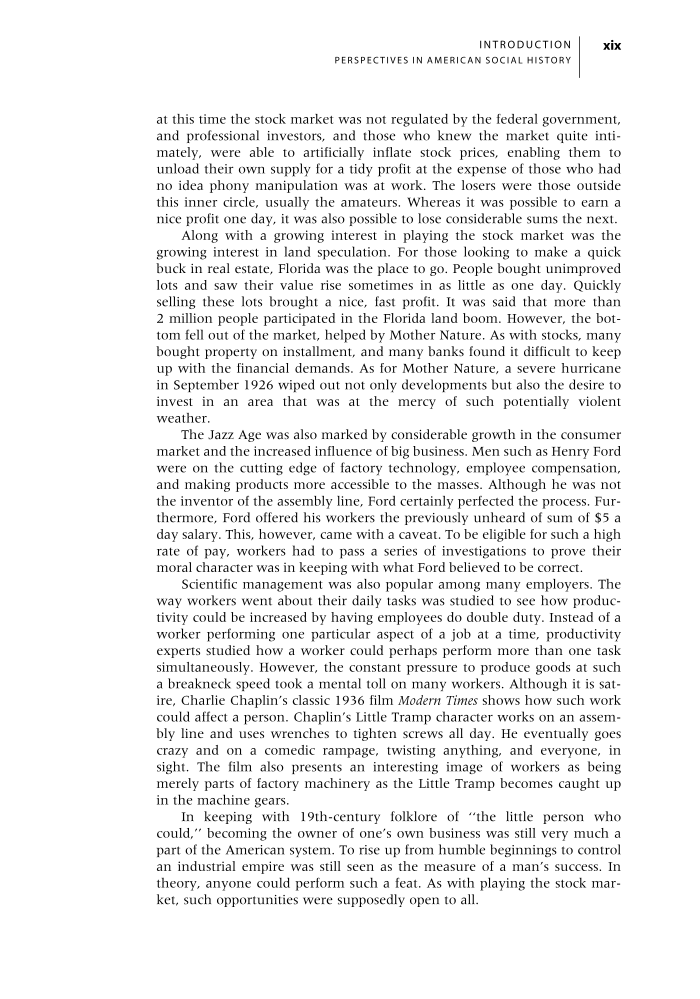at this time the stock market was not regulated by the federal government, and professional investors, and those who knew the market quite inti- mately, were able to artificially inflate stock prices, enabling them to unload their own supply for a tidy profit at the expense of those who had no idea phony manipulation was at work. The losers were those outside this inner circle, usually the amateurs. Whereas it was possible to earn a nice profit one day, it was also possible to lose considerable sums the next. Along with a growing interest in playing the stock market was the growing interest in land speculation. For those looking to make a quick buck in real estate, Florida was the place to go. People bought unimproved lots and saw their value rise sometimes in as little as one day. Quickly selling these lots brought a nice, fast profit. It was said that more than 2 million people participated in the Florida land boom. However, the bot- tom fell out of the market, helped by Mother Nature. As with stocks, many bought property on installment, and many banks found it difficult to keep up with the financial demands. As for Mother Nature, a severe hurricane in September 1926 wiped out not only developments but also the desire to invest in an area that was at the mercy of such potentially violent weather. The Jazz Age was also marked by considerable growth in the consumer market and the increased influence of big business. Men such as Henry Ford were on the cutting edge of factory technology, employee compensation, and making products more accessible to the masses. Although he was not the inventor of the assembly line, Ford certainly perfected the process. Fur- thermore, Ford offered his workers the previously unheard of sum of $5 a day salary. This, however, came with a caveat. To be eligible for such a high rate of pay, workers had to pass a series of investigations to prove their moral character was in keeping with what Ford believed to be correct. Scientific management was also popular among many employers. The way workers went about their daily tasks was studied to see how produc- tivity could be increased by having employees do double duty. Instead of a worker performing one particular aspect of a job at a time, productivity experts studied how a worker could perhaps perform more than one task simultaneously. However, the constant pressure to produce goods at such a breakneck speed took a mental toll on many workers. Although it is sat- ire, Charlie Chaplin’s classic 1936 film Modern Times shows how such work could affect a person. Chaplin’s Little Tramp character works on an assem- bly line and uses wrenches to tighten screws all day. He eventually goes crazy and on a comedic rampage, twisting anything, and everyone, in sight. The film also presents an interesting image of workers as being merely parts of factory machinery as the Little Tramp becomes caught up in the machine gears. In keeping with 19th-century folklore of ‘‘the little person who could,’’ becoming the owner of one’s own business was still very much a part of the American system. To rise up from humble beginnings to control an industrial empire was still seen as the measure of a man’s success. In theory, anyone could perform such a feat. As with playing the stock mar- ket, such opportunities were supposedly open to all. I N T R O D U C T I O N P E R S P E C T I V E S I N A M E R I C A N S O C I A L H I S T O R Y xix
Document Details My Account Print multiple pages
Print
You have printed 0 times in the last 24 hours.
Your print count will reset on at .
You may print 0 more time(s) before then.
You may print a maximum of 0 pages at a time.









































































































































































































































































































